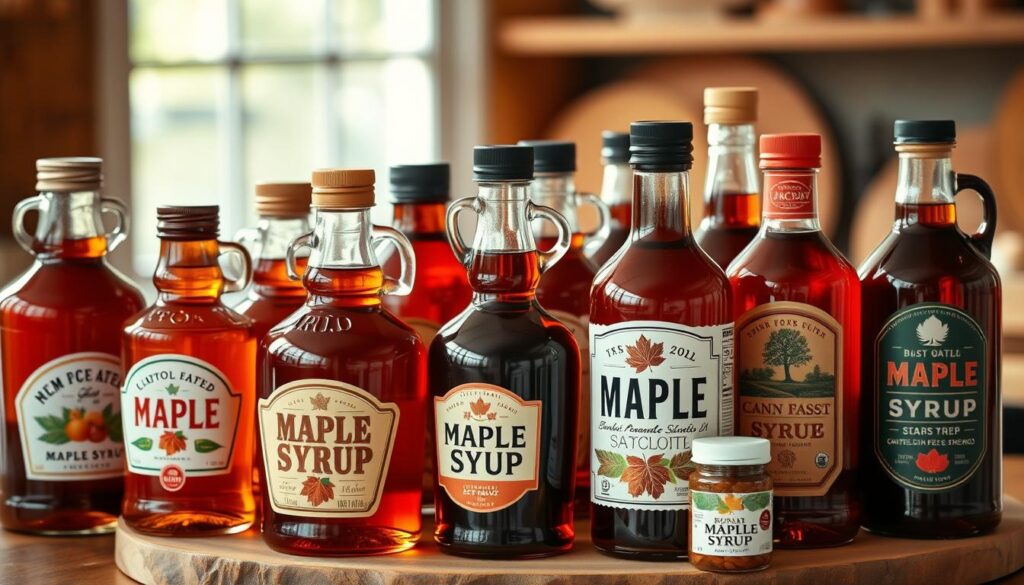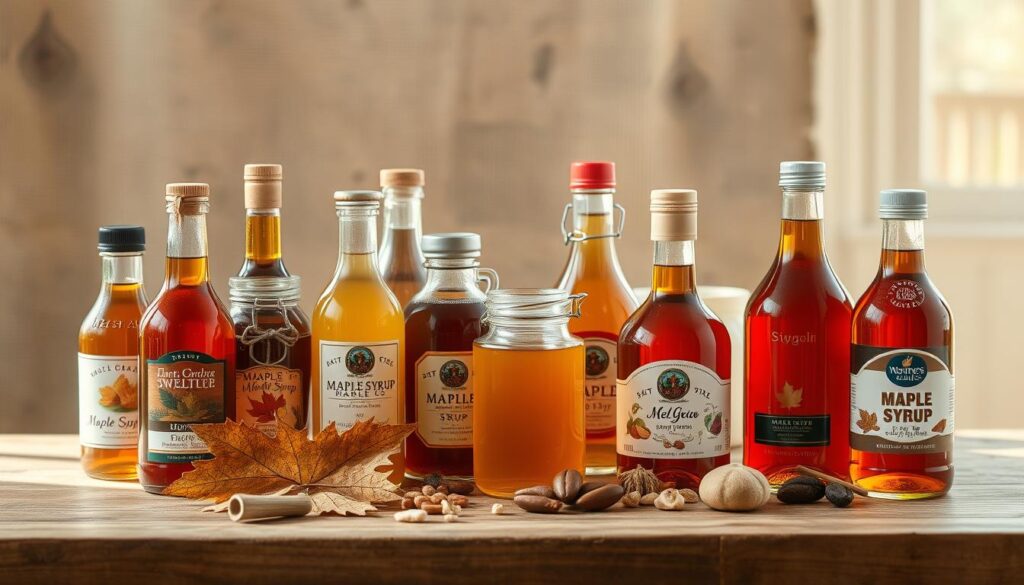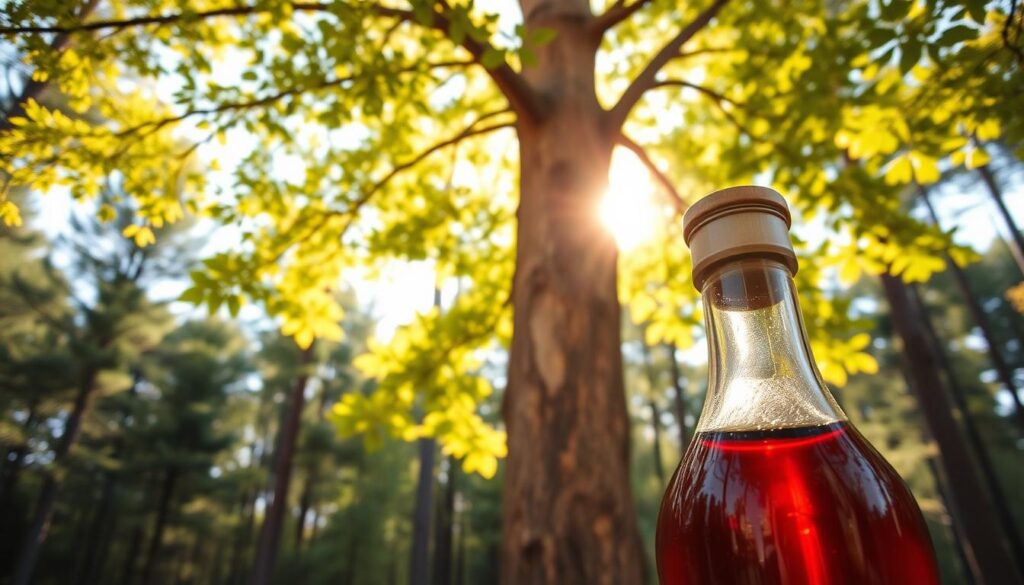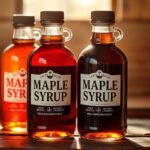Imagine a golden, amber liquid that makes simple dishes into something special. Natural maple syrup is more than just a sweetener. It’s a complex flavor that captures the essence of North American forests and traditional food making.
Maple syrup is a remarkable natural sweetener with depth and character. It’s made from maple trees during specific seasons. This liquid gold adds warmth and richness to many recipes.
Sugarmakers extract this liquid with great care. They turn simple tree sap into a complex, nuanced condiment. Each drop tells a story of patience, skill, and connection to natural food traditions.
Chefs and home cooks love maple syrup’s versatility. Its flavor can range from delicate to deep, depending on when it’s harvested and how it’s processed. Whether on pancakes or in savory marinades, it adds a unique touch to dishes.
Maple syrup is not just tasty; it’s also a sustainable food source. It’s deeply rooted in North American agricultural heritage. Its production supports local economies and keeps traditional harvesting methods alive.
The Rich History of Pure Maple Syrup Production
Pure maple syrup is a treasured tradition in North America. It has a long history, connecting indigenous peoples with the maple forests. This connection has lasted for centuries.
Indigenous Origins and Traditional Harvesting Methods
Native American tribes were the first to find maple trees’ sweetness. They created smart ways to make syrup long before Europeans came. Their methods included:
- Making V-shaped cuts in maple tree bark
- Collecting sap in wooden containers
- Boiling sap using heated stones
- Preserving syrup for winter
Evolution of Maple Syrup Processing
Early European settlers learned from Native Americans. They brought metal tools and better boiling methods. This changed the way syrup was made.
| Era | Key Developments |
|---|---|
| 1700s | Wooden spouts and buckets introduced |
| 1800s | Cast iron evaporators developed |
| Early 1900s | First commercial maple syrup operations established |
Modern Production Techniques
Today, maple syrup making mixes old ways with new tech. Sugarmakers use vacuum tubing and reverse osmosis. This makes syrup faster and keeps its true taste.
The art of making maple syrup is always growing. It combines old traditions with new ideas.
Understanding Maple Syrup Grades and Classifications
Maple syrup comes in many flavors, thanks to different grades. This system lets people pick the right syrup for their recipes.
The USDA has four main maple syrup grades:
- Golden Color, Delicate Taste: The lightest grade with a subtle maple syrup flavor
- Amber Color, Rich Taste: A more pronounced maple flavor with increased intensity
- Dark Color, Robust Taste: Strong, distinctive maple syrup flavor
- Very Dark Color, Strong Taste: Extremely intense maple flavor
Each grade has its own color and taste. Sugarmakers use special methods to classify syrups based on these.
The syrup’s color changes as it’s made. Syrups from early spring are lighter, while those from later are darker. This creates a range of flavors for everyone to enjoy.
Cooks choose grades based on what they’re making. Lighter syrups are great for sweet dishes. Darker ones are better for savory recipes.
The art of maple syrup grading represents a delicate balance between scientific measurement and sensory appreciation.
The Science Behind Maple Syrup Flavor
Natural maple syrup is more than just sweet. It’s a complex culinary wonder. Its unique flavor comes from a mix of chemical compounds and environmental factors.
The taste of maple syrup is amazing. It’s because of its special chemical makeup. Scientists have found many elements that make its flavor rich and complex:
- Over 300 distinct flavor compounds
- Complex sugar molecule structures
- Organic acids and amino acids
- Trace mineral content
Chemical Composition and Taste Profiles
Natural maple syrup has a complex mix of molecules. These molecules form during the evaporation process. The process starts when tree sap is heated, leading to chemical reactions.
Natural Flavor Compounds
The main flavor compounds in maple syrup are furanones and phenolic derivatives. These tiny elements give maple syrup its sweetness and complex aromas. They make maple syrup different from other natural sweeteners.
Terroir Impact on Taste
Where maple syrup is made affects its flavor. Soil, tree genetics, and climate all add unique touches. Sugarmakers know that each forest makes maple syrup with its own special taste.
“The forest writes the recipe, and we simply capture its essence.” – Traditional Sugarmaker Wisdom
Nutritional Benefits of Natural Maple Syrup
Natural maple syrup is more than a sweetener. It’s a golden liquid packed with nutritional benefits. Unlike refined sugar, it has essential minerals and antioxidants. These make it a healthier choice.
Maple syrup nutrition facts show it’s full of good stuff. It’s loaded with compounds that are great for you:
- Zinc: Supports immune function
- Manganese: Helps bone health and metabolism
- Calcium: Strengthens bones and teeth
- Potassium: Regulates heart and muscle function
Studies show maple syrup does more than just taste good. The syrup contains polyphenols, which are antioxidants. These protect cells and may help reduce inflammation.
| Nutrient | Amount per 1/4 cup |
|---|---|
| Calories | 200 |
| Manganese | 33% Daily Value |
| Zinc | 15% Daily Value |
While maple syrup should be used in moderation, it’s a better choice than refined sugars. Its natural origin and minimal processing make it a healthier option.
Pure maple syrup: Nature’s sweet superfood with hidden nutritional treasures.
Organic Maple Syrup: What Makes It Special
Organic maple syrup is more than just a sweetener. It’s a premium product that cares about the environment and quality. It ensures safety for both people and forests.
Organic maple syrup has special benefits. Its making process keeps nature and food close, with little harm to the environment.
Certification Requirements
To get organic certification for maple syrup, there are strict rules:
- No synthetic pesticides or chemicals near maple trees
- Sustainable forest management practices
- Regular environmental and production inspections
- Documented traceability of maple syrup origins
Environmental Impact
Organic maple syrup helps protect forests. It uses careful harvesting to keep forests healthy. This protects wildlife and keeps the ecosystem balanced.
| Environmental Practice | Benefit |
|---|---|
| Selective Tree Tapping | Prevents tree damage |
| Minimal Forest Intervention | Preserves natural habitat |
| Sustainable Harvesting | Maintains maple tree population |
Health Advantages
Maple syrup is good for you, not just tasty. Organic types are healthier because they have fewer chemicals. Antioxidants, minerals, and natural compounds make them better than refined sugars.
- Lower pesticide residue
- Higher mineral content
- Natural nutrient preservation
Choosing organic maple syrup supports green farming. It gives you a sweetener that’s full of nutrients and connects you to nature.
Top-Rated Best Maple Syrup Brands

Finding the best maple syrup brands is all about knowing the difference between artisanal and commercial syrup. People look for quality, real flavor, and eco-friendly practices.
Some maple syrup brands stand out to experts and fans. They are known for their top-notch syrup:
- Butternut Mountain Farm (Vermont) – Known for small-batch premium grade A syrup
- Crown Maple (New York) – Offers organic, single-origin maple syrups
- Maple Grove Farms – A long-standing family-owned brand with consistent quality
- Burton’s Maplewood Farm – Specializes in hand-crafted, wood-fired maple syrup
Choosing the best maple syrup brands means looking at a few important things. The syrup’s grade, how it’s made, and where it comes from all affect its taste and quality. Real maple syrup from reliable sources gives you a true taste.
When looking for the best maple syrup brands, focus on:
- Organic certification
- Transparent production methods
- Regional authenticity
- Flavor complexity
“True maple syrup is a craft, not just a condiment.” – Maple Syrup Expert
Every brand has its own special touch, showing the deep history of maple syrup in North America’s forests.
Maple Syrup Flavor: Understanding Taste Variations
The world of maple syrup flavor is complex and fascinating. Each bottle has a unique story, showing the environment where maple trees grow. Knowing these flavor differences can change how we enjoy this natural sweetener.
Maple syrup flavor comes from climate, soil, and how it’s harvested. Sugarmakers make these liquids with care. They want each drop to show the essence of their maple grove.
Light vs. Dark Maple Syrup Grades
Maple syrup grades show different flavors as the season changes:
- Golden Color, Delicate Taste: Early syrup with a mild flavor
- Amber Color, Rich Taste: Mid-season syrup with a stronger maple taste
- Dark Color, Robust Taste: Late syrup with a deep, intense maple flavor
Regional Flavor Differences
Where syrup comes from greatly affects its taste. Different places have unique flavors due to their environments.
| Region | Flavor Characteristics | Unique Notes |
|---|---|---|
| Vermont | Balanced, Classic | Rich mineral undertones |
| Quebec | Intense, Complex | Woody, deep maple essence |
| New Hampshire | Light, Delicate | Subtle caramel hints |
“The maple syrup flavor is nature’s poetry, written in sweet, liquid script.” – Anonymous Sugarmaker
Cooking with Maple Syrup: Basic Techniques
Maple syrup recipes add a special touch to food with their natural sweetness and flavor. It’s important to know how maple syrup works in cooking and baking. Unlike regular sugars, maple syrup adds a unique taste to both sweet and savory dishes.
Here are key techniques for using maple syrup in your cooking:
- Substitution Ratio: Replace sugar with maple syrup using a 3/4 cup of syrup for every 1 cup of sugar
- Reduce liquid ingredients by 2-4 tablespoons to maintain recipe consistency
- Lower oven temperature by 25 degrees to prevent over-browning
Maple syrup reacts differently when heated than other sweeteners. Its sugars caramelize fast, adding deep flavors. Professional chefs suggest using grade A medium amber maple syrup for the best results.
Try maple syrup in many different recipes:
- Marinades for meats
- Glazes for roasted vegetables
- Baking substitutes
- Salad dressing sweetener
Maple syrup isn’t just for pancakes – it’s a sophisticated ingredient that transforms ordinary recipes into extraordinary culinary experiences.
Learning about temperature control and precise measurements will make you a pro at maple syrup recipes. You’ll be able to cook with confidence and creativity.
Creative Culinary Applications Beyond Breakfast
Maple syrup is more than just for pancakes and waffles. It turns simple dishes into amazing meals. It’s a special ingredient for creative cooking.
Maple syrup opens up a world of flavors. It pushes the limits of what we think food can be. Chefs and home cooks are finding new ways to use it in their recipes.
Savory Dishes and Marinades
Maple syrup makes savory dishes taste amazing. It adds a sweet touch to meats and veggies. Try it in:
- Glazed salmon with maple-soy reduction
- Maple-bourbon chicken marinade
- Roasted root vegetables with maple drizzle
Dessert Innovations
Dessert lovers can try maple syrup in new ways. Unexpected combinations lead to incredible tastes:
- Maple crème brûlée
- Maple pecan tart
- Maple-infused ice cream
Beverage Recipes
Maple syrup is also great in drinks. It’s used in both alcoholic and non-alcoholic beverages:
| Beverage Type | Maple Syrup Recipe |
|---|---|
| Cocktails | Maple Old Fashioned |
| Non-Alcoholic | Maple Chai Latte |
| Smoothies | Maple Banana Protein Smoothie |
“Maple syrup isn’t just a condiment—it’s a culinary canvas waiting to be explored.” – Chef Michael Smith
Using maple syrup in cooking can make any meal special. It turns everyday food into something memorable and exciting.
Storing and Preserving Maple Syrup
Keeping pure maple syrup fresh is key to its taste and quality. Those who make and enjoy maple syrup know it’s important to store it right. This helps keep it in top condition.
Temperature is very important when storing maple syrup. The best places are:
- Cool, dark pantry or refrigerator
- Sealed glass or food-grade plastic containers
- Away from direct sunlight and heat sources
Unopened maple syrup can last up to two years if stored well. After opening, it’s vital to keep it in the fridge to avoid spoilage. Sometimes, it might crystallize, but that doesn’t mean it’s bad.
Here are some tips for long-term storage:
- Freezing in airtight containers
- Using sterilized glass jars
- Checking for mold growth periodically
Experts say to remove any surface mold by skimming and reboiling the syrup. This helps it last longer.
Signs it’s time to throw away maple syrup include mold, bad smells, or color changes. By following these tips, you can enjoy your maple syrup for months or years.
Seasonal Considerations for Maple Syrup Production
The world of making pure maple syrup is all about nature’s seasonal rhythm. Sugarmakers know that the syrup’s flavor comes from the right mix of weather in late winter and early spring.
Maple trees go through a big change when the weather is just right. The sap flows best when it’s cold at night and warm during the day. This mix of temperatures is perfect for getting sap from the trees.
Peak Harvesting Times
The time to harvest maple syrup usually lasts 4-6 weeks, from February to April. Different places have their own best times:
- Northern states like Vermont: Late February to early April
- Midwestern regions: March to mid-April
- Southern maple regions: Shorter harvest periods in February
Weather Impact on Flavor
The weather greatly affects the taste of maple syrup. Changes in temperature, rain, and sunlight all play a part. Sap collected early in the season makes lighter syrup, while later sap makes darker syrup.
Climate change is making it harder to make maple syrup the old way. Weather that’s not as predictable can cut short the harvest time and mess with the sap’s quality. Sugarmakers have to find new ways to keep their syrup tasting good, even when the weather is different.
Maple Syrup Alternatives and Substitutes
Natural maple syrup is a special treat in cooking and baking. But sometimes, we need something else. Knowing the right substitute can change how a recipe tastes.

Looking for natural maple syrup replacements, we find several options. Each has its own taste:
- Honey: A natural sweetener with complex flavor notes
- Agave nectar: Lower glycemic index alternative
- Brown rice syrup: Milder sweetness profile
- Coconut nectar: Unique tropical undertone
Choosing the right one depends on what you need. Texture, sweetness intensity, and nutritional content are key.
| Substitute | Sweetness Level | Best Used In |
|---|---|---|
| Honey | High | Baking, marinades |
| Agave Nectar | Medium-High | Beverages, desserts |
| Brown Rice Syrup | Low | Granola, energy bars |
While there are alternatives, natural maple syrup is hard to beat. Each substitute has its own special taste. So, it’s important to try different ones to find the best for your recipe.
Economic Impact of Maple Syrup Industry
The pure maple syrup industry is a big deal in North America. Places like Quebec, Vermont, and New Hampshire have turned maple syrup making into a big economic force. They support thousands of jobs and bring in a lot of money.
Maple syrup does more than just grow on trees. It brings in money in many ways:
- Direct farm production
- Processing and packaging
- Tourism and maple festivals
- Export markets
- Specialty food manufacturing
Canada leads the world in making maple syrup, making up about 71% of it. Quebec alone makes over $300 million a year from maple syrup sales. This shows how big the industry is.
But, climate change is a problem for maple syrup makers. They need new ways to keep making syrup. They’re using new tech to stay in business.
“Maple syrup isn’t just a sweet condiment—it’s an economic driver for rural communities” – Agricultural Economic Research Center
Both small and big syrup makers help the economy. Maple syrup offers a steady income in farming areas.
Sustainability in Maple Syrup Production
The organic maple syrup industry is at a key point. It combines caring for the environment with old farming ways. Making syrup in a sustainable way is key to keeping maple forests healthy and the ecosystems they support.
Keeping maple forests safe needs a big plan. It must protect nature and also make money. Sugarmakers have found new ways to care for maple trees and keep making high-quality syrup.
Environmental Considerations
Important things to think about in maple syrup making are:
- Keeping forests diverse
- Not harming soil or trees when tapping
- Using good forest management
- Lowering carbon emissions in syrup making
Future of Sustainable Practices
The future of organic maple syrup looks bright. New tech and conservation efforts are coming. These changes are changing how sugarmakers manage forests and make syrup.
- Energy-saving evaporation systems
- Modern ways to watch over forests
- Methods that help trees adapt to climate change
- Practices that help forests grow back
Sustainable maple syrup making is very important. It shows how to care for the environment. By protecting maple forests and using green practices, the syrup industry can keep this valuable resource for the future.
Common Myths and Misconceptions

Many people think maple syrup is a super healthy choice. But, the truth is more complex. Knowing the real deal about maple syrup helps us make better food choices.
There are many myths about maple syrup that need to be cleared up. Let’s look at some of the most common ones:
- Myth: Maple syrup is a sugar-free sweetener
Reality: Maple syrup is sugar, and we should eat it in small amounts. It has minerals like zinc and manganese, but it’s not low in calories.
- Myth: All maple-flavored syrups are pure maple syrup
Reality: Many syrups are not really maple syrup. They use fake flavors or very little real maple. True maple syrup comes from maple sap and is processed carefully.
- Myth: Darker maple syrup is less nutritious
Actually, darker maple syrup has more antioxidants and nutrients than lighter ones.
While maple syrup has some good points, it’s not a magic food. It has natural minerals and antioxidants. But, it should be part of a healthy diet.
“Understanding the true nature of maple syrup helps consumers make more informed dietary choices.” – Maple Nutrition Experts
Always read labels and pick pure maple syrup. Enjoy it as part of a healthy diet. Knowing the facts helps us see the truth about natural sweeteners.
Conclusion
Natural maple syrup is more than a sweetener. It’s a symbol of North America’s rich culture and cooking traditions. From ancient harvesting to today’s eco-friendly ways, maple syrup fascinates people everywhere with its unique flavors.
The story of maple syrup is a blend of nature and human creativity. Sugarmakers turn tree sap into a special ingredient. This golden liquid is used in many dishes, not just breakfasts. It brings a special taste that honors tradition and skill.
More people want to buy sustainable and handmade foods, and maple syrup is at the top of the list. It’s good for the planet, healthy, and has amazing flavors. This makes it a favorite in cooking and a symbol of quality food making.
Exploring maple syrup opens a door to a world of tradition and nature. It connects us to the land and the art of making food. From Vermont to Canada, maple syrup shows the beauty of handmade food.



